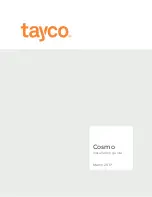
12
Surface Placement & Cable Connections
Set the Surface on the counter, or into the cutout, and verify its palm
rest is parallel with the countertop edge. The weight of each Surface
should hold it in position when set on the countertop. If the cutout is
oversized, allowing the Surface to shift slightly, place thin soft rubber pads
under the side panels or use angled shims, placed between the countertop
and each side of the chassis, to firmly hold the Surface in position.
To connect the Surface’s DC cable, and the Ethernet cable that connects
the Surface to the Mix Engine, remove the upper rear cosmetic cover from
the back of the meter bridge. Remove the black #1 Phillips screws from
along the bottom of the upper rear cover. Since its top edge fits into a slot
in the meter bridge’s top cover, the upper rear cover may need to be
pulled down slightly to pull it out of the slot.
When removed, the network host board, with the DC power jack and
RJ45 Ethernet jack is revealed (Figure 2-2). Route the supplied DC cable,
and the customer-supplied category cable (CAT5, CAT5e, or CAT6), up
through the access holes in the bottom of the chassis. Plug and latch the
category cable into the upper shielded RJ45 Ethernet jack. Plug the DC
cable into the DC Power Jack, tightening its housing onto the threaded
jack. Reattach the upper rear cover.
Figure 2-2 Surface rear view (upper rear cover removed)
Route the CAT5e cable from the Surface to the back of the PR&E Mix
Engine (Figure 2-3), plugging it into Port 4 on the built-in ETHERNET
switch. Route the DC cable to the 1620 Supply and connect it to the
threaded DC Jack on the rear of the supply.
If a redundant 1620 Supply and FSI-DMX/EMX Failsafe Interface are
being installed, connect the DC cable from the Surface to the DC OUT jack
on the Failsafe Interface. Connect the two short DC cables supplied with
the FSI-DMX/EMX between the two DC IN connectors on the Failsafe
Interface and the DC Out jacks on each 1620 Supply. The two 1620
power supplies should connect to different AC circuits, if possible.
Figure 2-3 PR&E Mix Engine, Rear Panel Partial View, Ethernet Connections
PR&E MIX ENGINE CONNECTIONS
To facilitate wiring the PR&E Mix Engine, create a wire list, listing all
connections to and from peripheral devices. Identify and create labels for
each end of each audio, logic, and network cable. List these connections in
a master facility wiring logbook to ease installation, future system wiring
and equipment changes, and system troubleshooting.
Audio cabling to and from the Mix Engine should always be run with the
maximum practical distance from all AC mains wiring. The Surface’s power
cable only carries DC voltage, so audio wiring can run parallel to or even
be tie wrapped with this cable without problem.
All line level analog audio, AES/EBU, and logic signals connect to the Mix
Engine on RJ45 jacks. Pin out signal lists, and the standard category wire
colors used for the analog and digital audio connectors and the Logic
connector are shown in Figure 2-4.
Figure 2-4 Audio & Logic RJ45 Pin Outs & Signals
For most applications, either shielded twisted pair (STP) or unshielded
twisted pair (UTP) wiring can be used interchangeably. When crimping
your own CAT5 cables, UTP has an advantage because it’s a lot easier to
crimp than STP wiring. To simplify audio wiring, standard length straight-
thru CAT5 cables can be used with RJ45 Audio Adapters to connector to
peripheral devices.
Summary of Contents for EMX
Page 4: ...4 ...













































